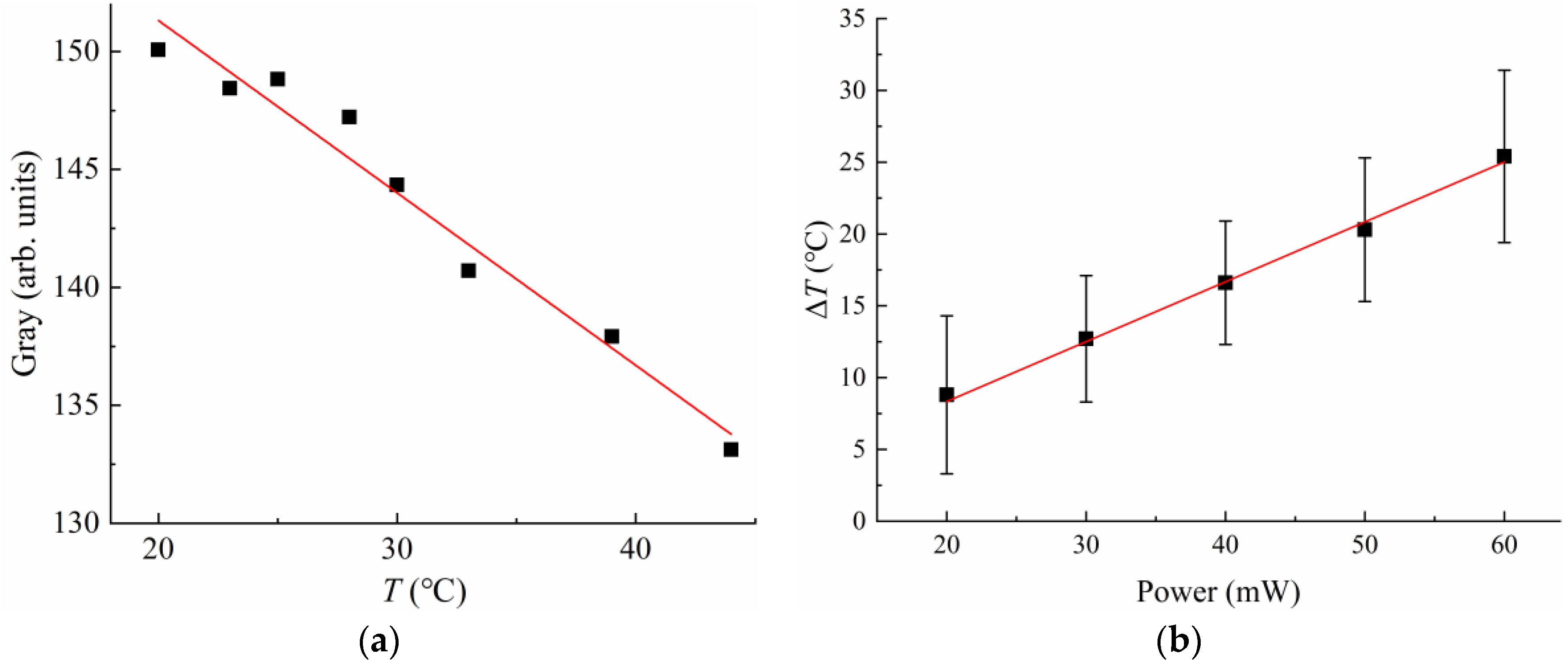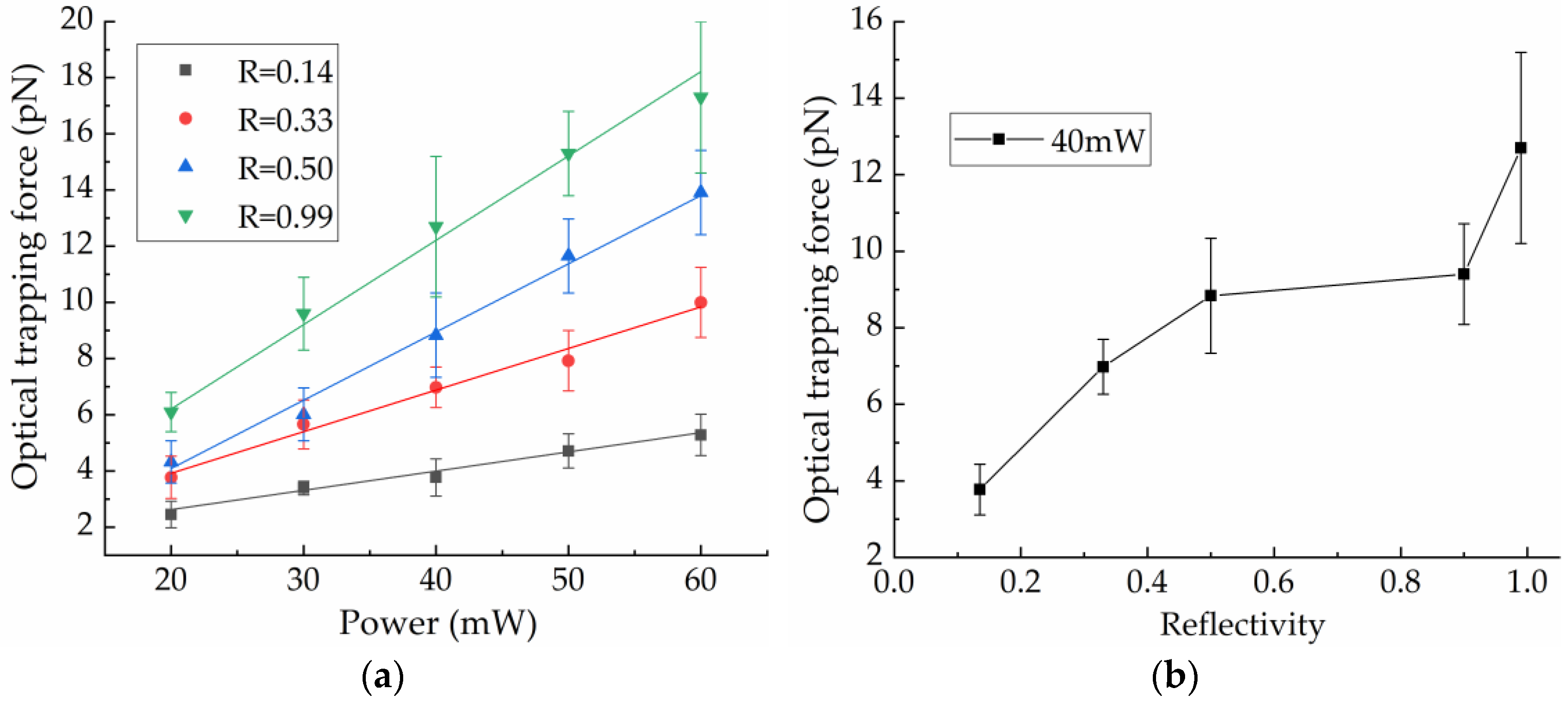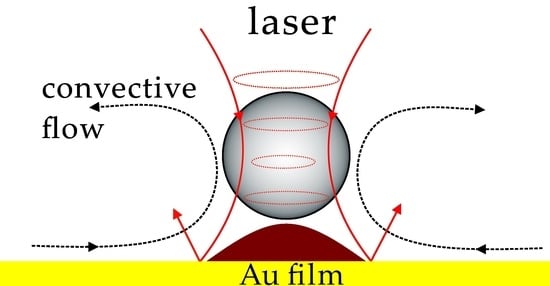Experimental Study of Transverse Trapping Forces of an Optothermal Trap Close to an Absorbing Reflective Film
Abstract
:1. Introduction
2. Materials and Methods
2.1. Setup and Materials
2.2. Transverse Trapping Force Measurement Method
3. Results and Discussion
3.1. Measurement of Temperature Increase
3.2. Trapping Forces of Optical Trap and Optothermal Trap
3.3. Thermal Forces of Optothermal Trap
3.4. Observation of Individual Action of Fcc and Fth
3.5. Optical Force of Standing-Wave Trap with Different Reflectivities
4. Conclusions
Author Contributions
Funding
Institutional Review Board Statement
Informed Consent Statement
Data Availability Statement
Acknowledgments
Conflicts of Interest
References
- Lin, L.; Hill, E.H.; Peng, X.; Zheng, Y. Optothermal Manipulations of Colloidal Particles and Living Cells. Acc. Chem. Res. 2018, 51, 1465–1474. [Google Scholar] [CrossRef]
- Liu, S.; Lin, L.; Sun, H.B. Opto-Thermophoretic Manipulation. ACS Nano 2021, 15, 5925–5943. [Google Scholar] [CrossRef] [PubMed]
- Chen, J.; Loo, J.F.C.; Wang, D.; Zhang, Y.; Kong, S.K.; Ho, H.P. Thermal Optofluidics: Principles and Applications. Adv. Opt. Mater. 2020, 8, 1900829. [Google Scholar] [CrossRef]
- Chen, Z.; Li, J.; Zheng, Y. Heat-Mediated Optical Manipulation. Chem. Rev. 2022, 122, 3122–3179. [Google Scholar] [CrossRef]
- Jiang, H.-R.; Wada, H.; Yoshinaga, N.; Sano, M. Manipulation of Colloids by a Nonequilibrium Depletion Force in a Temperature Gradient. Phys. Rev. Lett. 2009, 102, 208301. [Google Scholar] [CrossRef] [PubMed] [Green Version]
- Fränzl, M.; Cichos, F. Hydrodynamic Manipulation of Nano-Objects by Thermo-Osmotic Flows. Nat. Commun. 2022, 13, 656. [Google Scholar] [CrossRef] [PubMed]
- Zenteno-Hernandez, J.A.; Lozano, J.V.; Sarabia-Alonso, J.A.; Ramírez-Ramírez, J.; Ramos-García, R. Optical trapping in the presence of laser-induced thermal effects. Opt. Lett. 2020, 45, 3961–3964. [Google Scholar] [CrossRef] [PubMed]
- Zhong, M.-C.; Liu, A.-Y.; Ji, F. Opto-thermal oscillation and trapping of light absorbing particles. Opt. Express 2019, 27, 29730–29737. [Google Scholar] [CrossRef]
- Flores-Flores, E.; Torres-Hurtado, S.A.; Páez, R.; Ruiz, U.; Beltrán-Pérez, G.; Neale, S.L.; Ramirez-San-Juan, J.C.; Ramos-García, R. Trapping and manipulation of microparticles using laser-induced convection currents and photophoresis. Biomed. Opt. Express 2015, 6, 4079–4087. [Google Scholar] [CrossRef] [Green Version]
- Frueh, J.; Rutkowski, S.; Si, T.; Ren, Y.-X.; Gai, M.; Tverdokhlebov, S.I.; Qiu, G.; Schmitt, J.; He, Q.; Wang, J. Direct measurement of thermophoretic and photophoretic force acting on hot micromotors with optical tweezers. Appl. Surf. Sci. 2021, 549, 149319. [Google Scholar] [CrossRef]
- Frueh, J.; Rutkowski, S.; Si, T.; Gai, M.; Gao, C.; Tverdokhlebov, S.I.; Qiu, G.; Schmitt, J.; He, Q.; Ren, Y.-X.; et al. Propulsion Mechanisms of Light-Driven Plasmonic Colloidal Micromotors. Adv. Photonics Res. 2021, 3, 2100189. [Google Scholar] [CrossRef]
- Zhong, M.-C.; Wang, Z.-Q.; Li, Y.-M. Oscillations of absorbing particles at the water-air interface induced by laser tweezers. Opt. Express 2017, 25, 2481–2488. [Google Scholar] [CrossRef]
- Lin, L.; Peng, X.; Mao, Z.; Li, W.; Yogeesh, M.N.; Rajeeva, B.B.; Perillo, E.P.; Dunn, A.K.; Akinwande, D.; Zheng, Y. Bubble-Pen Lithography. Nano Lett. 2016, 16, 701–708. [Google Scholar] [CrossRef]
- Li, B.-W.; He, J.-W.; Bai, W.; Wang, H.-D.; Ji, F.; Zhong, M.-C. An approach of bubble generation and manipulation by using the photothermal effects of laser irradiation on light absorbing particles. Rev. Sci. Instrum. 2021, 92, 114902. [Google Scholar] [CrossRef] [PubMed]
- Ortega-Mendoza, J.G.; Sarabia-Alonso, J.A.; Zaca-Morán, P.; Padilla-Vivanco, A.; Toxqui-Quitl, C.; Rivas-Cambero, I.; Ramirez-Ramirez, J.; Torres-Hurtado, S.A.; Ramos-García, R. Marangoni force-driven manipulation of photothermally-induced microbubbles. Opt. Express 2018, 26, 6653–6662. [Google Scholar] [CrossRef]
- Sarabia-Alonso, J.A.; Ortega-Mendoza, J.G.; Mansurova, S.; Muñoz-Pérez, F.M.; Ramos-García, R. 3D trapping of microbubbles by the Marangoni force. Opt. Lett. 2021, 46, 5786–5789. [Google Scholar] [CrossRef]
- Yan, X.; Xu, J.; Meng, Z.; Xie, J.; Wang, H. A New Mechanism of Light-Induced Bubble Growth to Propel Microbubble Piston Engine. Small 2020, 16, 2001548. [Google Scholar] [CrossRef]
- Chen, Y.; Yang, J.; Wu, J.; Li, Z.; Liu, S.; Zhong, H.; Zhou, R.; Luo, A.; Ho, H.P.; He, S.; et al. Generation and manipulation of oil-in-water micro-droplets by confined thermocapillary microvortices. Opt. Lett. 2020, 45, 1998–2001. [Google Scholar] [CrossRef] [PubMed]
- Helden, L.; Eichhorn, R.; Bechinger, C. Direct measurement of thermophoretic forces. Soft Matter 2015, 11, 2379–2386. [Google Scholar] [CrossRef] [Green Version]
- Duhr, S.; Braun, D. Thermophoretic depletion follows Boltzmann distribution. Phys. Rev. Lett. 2006, 96, 168301. [Google Scholar] [CrossRef] [Green Version]
- Peng, X.; Chen, Z.; Kollipara, P.S.; Liu, Y.; Fang, J.; Lin, L.; Zheng, Y. Opto-thermoelectric microswimmers. Light Sci. Appl. 2020, 9, 141. [Google Scholar] [CrossRef] [PubMed]
- Lin, L.; Kollipara, P.S.; Kotnala, A.; Jiang, T.; Liu, Y.; Peng, X.; Korgel, B.A.; Zheng, Y. Opto-thermoelectric pulling of light-absorbing particles. Light Sci. Appl. 2020, 9, 34. [Google Scholar] [CrossRef] [PubMed] [Green Version]
- Kotnala, A.; Kollipara, P.S.; Zheng, Y. Opto-thermoelectric speckle tweezers. Nanophotonics 2020, 9, 927–933. [Google Scholar] [CrossRef] [PubMed] [Green Version]
- Ren, Y.-X.; Zeng, X.; Zhou, L.-M.; Kong, C.; Mao, H.; Qiu, C.-W.; Tsia, K.K.; Wong, K.K.Y. Photonic Nanojet Mediated Backaction of Dielectric Microparticles. ACS Photonics 2020, 7, 1483–1490. [Google Scholar] [CrossRef]
- Shvedov, V.G.; Hnatovsky, C.; Eckerskorn, N.; Rode, A.V.; Krolikowski, W. Polarization-sensitive photophoresis. Appl. Phys. Lett. 2012, 101, 051106. [Google Scholar] [CrossRef]
- Gong, Z.; Pan, Y.-L.; Wang, C. Optical configurations for photophoretic trap of single particles in air. Rev. Sci. Instrum. 2016, 87, 103104. [Google Scholar] [CrossRef]
- Miniewicz, A.; Quintard, C.; Orlikowska, H.; Bartkiewicz, S. On the origin of the driving force in the Marangoni propelled gas bubble trapping mechanism. Phys. Chem. Chem. Phys. 2017, 19, 18695–18703. [Google Scholar] [CrossRef]
- Qian, Y.; Neale, S.L.; Marsh, J.H. Microparticle manipulation using laser-induced thermophoresis and thermal convection flow. Sci. Rep. 2020, 10, 19169. [Google Scholar] [CrossRef]
- Zhang, Y.; Tang, X.; Zhang, Y.; Liu, Z.; Yang, X.; Zhang, J.; Yang, J.; Yuan, L. Optical attraction of strongly absorbing particles in liquids. Opt. Express 2019, 27, 12414–12423. [Google Scholar] [CrossRef]
- Kumari, P.; Dharmadhikari, J.A.; Dharmadhikari, A.K.; Basu, H.; Sharma, S.; Mathur, D. Optical trapping in an absorbing medium: From optical tweezing to thermal tweezing. Opt. Express 2012, 20, 4645–4652. [Google Scholar] [CrossRef]
- Jonáš, A.; Zemánek, P.; Florin, E.-L. Single-beam trapping in front of reflective surfaces. Opt. Lett. 2001, 26, 1466–1468. [Google Scholar] [CrossRef] [PubMed] [Green Version]
- Zemánek, P.; Jonáš, A.; Šrámek, L.; Liška, M. Optical trapping of Rayleigh particles using a Gaussian standing wave. Opt. Commun. 1998, 151, 273–285. [Google Scholar] [CrossRef]
- Zemánek, P.; Jonáš, A.; Šrámek, L.; Liška, M. Optical trapping of nanoparticles and microparticles by a Gaussian standing wave. Opt. Lett. 1999, 24, 1448–1450. [Google Scholar] [CrossRef] [PubMed]
- Jákl, P.; Šerý, M.; Ježek, J.; Liška, M.; Zemánek, P. Axial optical trap stiffness influenced by retro-reflected beam. J. Opt. A Pure Appl. Opt. 2007, 9, S251–S255. [Google Scholar] [CrossRef]
- Shilkin, D.A.; Lyubin, E.V.; Soboleva, I.V.; Fedyanin, A.A. Trap position control in the vicinity of reflecting surfaces in optical tweezers. JETP Lett. 2014, 98, 644–647. [Google Scholar] [CrossRef]
- Chvatal, L.; Brzobohaty, O.; Zemanek, P. Binding of a pair of Au nanoparticles in a wide Gaussian standing wave. Opt. Rev. 2015, 22, 157–161. [Google Scholar] [CrossRef]
- Wu, M.Y.; Ling, D.X.; Ling, L.; Li, W.; Li, Y.Q. Stable optical trapping and sensitive characterization of nanostructures using standing-wave Raman tweezers. Sci. Rep. 2017, 7, 42930. [Google Scholar] [CrossRef] [Green Version]
- Donato, M.G.; Brzobohatý, O.; Simpson, S.H.; Irrera, A.; Leonardi, A.A.; Lo Faro, M.J.; Svak, V.; Maragò, O.M.; Zemánek, P. Optical Trapping, Optical Binding, and Rotational Dynamics of Silicon Nanowires in Counter-Propagating Beams. Nano Lett. 2019, 19, 342–352. [Google Scholar] [CrossRef]
- Rafferty, A.; Preston, T.C. Trapping positions in a dual-beam optical trap. J. Appl. Phys. 2021, 130, 183105. [Google Scholar] [CrossRef]
- Zemánek, P.; Jonáš, A.; Jákl, P.; Ježek, J.; Šerý, M.; Liška, M. Theoretical comparison of optical traps created by standing wave and single beam. Opt. Commun. 2003, 220, 401–412. [Google Scholar] [CrossRef]
- Simmons, R.M.; Finer, J.T.; Chu, S.; Spudich, J.A. Quantitative measurements of force and displacement using an optical trap. Biophys. J. 1996, 70, 1813–1822. [Google Scholar] [CrossRef] [Green Version]
- Zhong, M.-C.; Liu, A.-Y.; Zhu, R. Optical assembling of micro-particles at a glass-water interface with diffraction patterns caused by the limited aperture of objective. Appl. Sci. 2018, 8, 1522. [Google Scholar] [CrossRef] [Green Version]
- Happel, J.; Brenner, H. Low Reynolds Number Hydrodynamics; Martinus Nijhoff Publishers: The Hague, The Netherlands, 1983. [Google Scholar]
- Lide, D.R. CRC Handbook of Chemistry and Physics, 82nd ed.; CRC Press LLC: Boca Raton, FL, USA, 2002. [Google Scholar]
- Šiler, M.; Ježek, J.; Jákl, P.; Pilát, Z.; Zemánek, P. Direct measurement of the temperature profile close to an optically trapped absorbing particle. Opt. Lett. 2016, 41, 870–873. [Google Scholar] [CrossRef]
- Xiang, Y.; Tang, X.; Min, C.; Rui, G.; Kuai, Y.; Lu, F.; Wang, P.; Ming, H.; Zhan, Q.; Yuan, X.; et al. Optical Trapping with Focused Surface Waves. Ann. Phys. 2020, 532, 1900497. [Google Scholar] [CrossRef]
- Mao, H.B.; Arias-Gonzalez, J.R.; Smith, S.B.; Tinoco, I.; Bustamante, C. Temperature control methods in a laser tweezers system. Biophys. J. 2005, 89, 1308–1316. [Google Scholar] [CrossRef] [Green Version]
- Lu, D.; Gámez, F.; Haro-González, P. Temperature Effects on Optical Trapping Stability. Micromachines 2021, 12, 954. [Google Scholar] [CrossRef]
- Hosokawa, C.; Tsuji, T.; Kishimoto, T.; Okubo, T.; Kudoh, S.N.; Kawano, S. Convection Dynamics Forced by Optical Trapping with a Focused Laser Beam. J. Phys. Chem. C 2020, 124, 8323–8333. [Google Scholar] [CrossRef]
- Kotnala, A.; Kollipara, P.S.; Li, J.; Zheng, Y. Overcoming Diffusion-Limited Trapping in Nanoaperture Tweezers Using Opto-Thermal-Induced Flow. Nano Lett. 2020, 20, 768–779. [Google Scholar] [CrossRef]






Publisher’s Note: MDPI stays neutral with regard to jurisdictional claims in published maps and institutional affiliations. |
© 2022 by the authors. Licensee MDPI, Basel, Switzerland. This article is an open access article distributed under the terms and conditions of the Creative Commons Attribution (CC BY) license (https://creativecommons.org/licenses/by/4.0/).
Share and Cite
Wang, H.-D.; Bai, W.; Zhang, B.; Li, B.-W.; Ji, F.; Zhong, M.-C. Experimental Study of Transverse Trapping Forces of an Optothermal Trap Close to an Absorbing Reflective Film. Photonics 2022, 9, 473. https://doi.org/10.3390/photonics9070473
Wang H-D, Bai W, Zhang B, Li B-W, Ji F, Zhong M-C. Experimental Study of Transverse Trapping Forces of an Optothermal Trap Close to an Absorbing Reflective Film. Photonics. 2022; 9(7):473. https://doi.org/10.3390/photonics9070473
Chicago/Turabian StyleWang, Hao-Dong, Wen Bai, Bu Zhang, Bo-Wei Li, Feng Ji, and Min-Cheng Zhong. 2022. "Experimental Study of Transverse Trapping Forces of an Optothermal Trap Close to an Absorbing Reflective Film" Photonics 9, no. 7: 473. https://doi.org/10.3390/photonics9070473
APA StyleWang, H.-D., Bai, W., Zhang, B., Li, B.-W., Ji, F., & Zhong, M.-C. (2022). Experimental Study of Transverse Trapping Forces of an Optothermal Trap Close to an Absorbing Reflective Film. Photonics, 9(7), 473. https://doi.org/10.3390/photonics9070473





